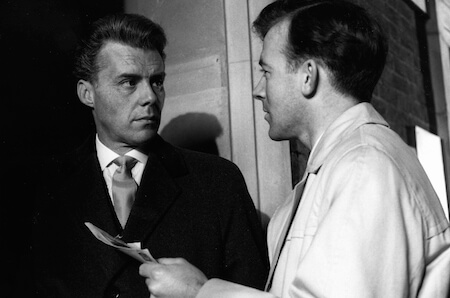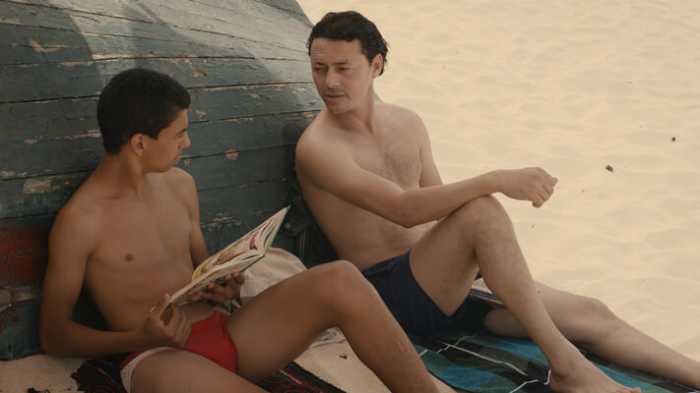A new retrospective series of old films made by queer filmmakers or about queer characters unspools at the Film Society of Lincoln Center April 22 through May 1. The 23 features and 24 shorts range from early silents and talkies to more experimental and avant-garde films. While certainly not comprehensive — “Zero for Conduct” and “The Children’s Hour are noticeably absent — “Queer Cinema Before Stonewall,” programmed by Thomas Beard, a programmer at large at Lincoln Center, offers viewers a chance to see LGBT representations on screen ranging from those thinly veiled to films overt and explicit.
One of the opening night presentations (Apr. 22, 8:30 p.m.) showcases three classic gay films. “Blood of a Poet” is Jean Cocteau’s 1930 masterpiece in which an artist’s (Enrique Riveros) painting and statue become animated. The artist soon ventures into a mirror, which leads to a hotel where he peeps through keyholes, witnessing a series of strange vignettes. Cocteau’s stylish film features acrobatics, snowball fights, and a strange suicide, but it is all beautifully rendered.
Some of Cocteau’s indelible imagery is echoed in “Un Chant d’Amour,” Jean Genet’s spellbinding 1950 silent film about two prisoners who are spied on by a guard (not unlike the artist peeping through keyholes). The eroticism on display here ranges from tender caresses to a more violent encounter, along with some pornographic ones.
Film Society of Lincoln Center celebrates cinema’s queer aesthetic pre-Stonewall
The third short work on the program is Kenneth Anger’s landmark 1947 avant-garde film “Fireworks,” about a young man (Anger) who seeks out rough trade. It offers suggestive and disturbing imagery in equal measure, including a shirtless, flexing sailor, a phallic Roman candle, and a scene of both milky and bloody sensuality. “Fireworks” was deemed both obscenity and art upon release.
One film worth seeking out is lesbian director Dorothy Arzner’s “The Wild Party” (Apr. 24, 1 p.m.), a fun, pre-code film from 1929 that stars “It Girl” Clara Bow as Stella Ames, an insouciant student at Winston College. Stella is a popular girl whose reputation is threatened when she accidently gets into a man’s bed on a train one night. The man turns out to be the new anthropology professor, James Gilmore (Frederic March), who reprimands Stella about decency. Gilmore and Stella eventually develop a relationship, but it is Stella’s love for her classmate Helen (Shirley O’Hara) that, while subtly presented, is perhaps more heartfelt.
Gay director George Cukor’s 1935 comedy “Sylvia Scarlett” (Apr. 24, 2:45 p.m.; Apr. 25, 4 p.m.) features Katherine Hepburn in a cross-dressing performance as the title character, a young woman who masquerades as a boy, Sylvester. “He” works with his father (Edmund Gwenn) and a stranger, Jimmy Monkley (Cary Grant), to swindle others. They have mixed success, but then “she” falls for a painter, Michael Fane (Brian Aherne), and reveals her ruse.
Cukor’s film is a mixed bag. He coaxes fine performances from the leads and displays a flair for some of the film’s madcap comedic moments, but “Sylvia Scarlett” doesn’t quite work. Its portrayal of gender roles was ahead of its time but the film never quite engages the emotions at play.
Two other gender-bending films in the series that were also ahead of their time are Edward D. Wood Jr.’s notorious 1953 drama “Glen or Glenda” (Apr. 24, 9 p.m.) and the 1914 silent film, “A Florida Enchantment.” A title card in Wood’s film urges audiences, “Judge ye not,” as it examines two cases of sexual difference: one involving transvestism, the other, transgender identity. Although the narration by a psychiatrist (Timothy Farrell) is didactic and there is a clunky framing device featuring a scientist (Bela Lugosi), who spouts strange things, the film articulates the “idiosyncratic” behavior of Glen (director Wood, billed as Daniel Davis) who finds comfort in wearing women’s clothing. He is not a homosexual, it is explained, and is engaged to Barbara (Dolores Fuller). Glen debates telling her his “secret” prior to their marriage. The other storyline concerns Alan (“Tommy” Haynes), a pseudo-hermaphrodite who undergoes gender reassignment. As Anne, Alan is transformed from “acting” as a woman to being one. “Glen Or Glenda” may be known for its Z-grade production values and an intentionally funny, over-the-top style, but it’s an oddly compassionate film with two “happy” endings.
In “A Florida Enchantment” (Apr. 26, 6:45 p.m.), Lillian Travers (Edith Storey) ingests a magic seed that transforms her into Lawrence Talbot. She grows (and shaves) a mustache, dresses in men’s clothing, and kisses all the women she can. Her fiancé, Fred Cassadene (director Sidney Drew), also swallows the seed and cross-dresses. The film’s farcical elements involve sexual confusion and mistaken identity — a murder is suspected after Lillian transforms into Lawrence on a boat and her clothes are found — and several comic scenes more or less work. The appearance of several characters in blackface, though, is hard to swallow.
Other silent films featured in the “Queer Cinema Before Stonewall” series include “Lot in Sodom” (Apr. 23, 3 p.m.) from 1933, a homoerotic short featuring a bevy of bare-chested males in expressionistic poses. Directors James Sibley Watson and Melville Webber use inventive visuals — repetitive imagery, superimpositions, double exposures, time-lapse photography — to tell this biblical story with panache. The film is paired with “Salomé,” a dazzling 1923 adaptation of Oscar Wilde’s “historical fantasy” that features Alla Nazimova in the title role. Salomé dances provocatively and wants the head of Jokanaan the Prophet (Nigel De Brulier). The film is stylish beyond belief, with fabulous costumes — including some truly spectacular headdresses — and gorgeous set design and lighting that make it worth seeing.
Moving into the postwar years, two Hollywood films, both based on plays, portray gay students. In both cases, because of the Motion Picture Production Code, the word “homosexual” was taboo and the three young men were all tragic figures.
Alfred Hitchcock’s 1948 Technicolor feature “Rope” (Apr. 24, 4:45 p.m.; Apr. 25, 2 p.m.) — a variation on the Leopold and Loeb “thrill kill” story — is based on Patrick Hamilton’s play. Gay screenwriter Arthur Laurents acknowledged that the killers, played by then-closeted actors John Dall and Farley Granger, were lovers, but the film only implies that. “Rope” was most noted at the time for Hitchcock’s experiment in filming the taut drama in one continuous take.
Bisexual director Vincente Minnelli’s “Tea and Sympathy” (Apr. 27, 6:30 p.m.; Apr. 28, 4:30 p.m.) from 1956, was adapted from Robert Anderson’s play. In this sensitive drama, prep schooler Tom Lee (John Kerr) is consistently mocked for not being a “regular fellow.” He is feminized and bullied by his classmates and housemaster, Bill (Leif Erickson), who are guardians of a hyper-masculine culture. Tom’s situation prompts Laura Reynolds (Deborah Kerr), Bill’s lonely wife, to reach out to the young man emotionally to help him become stronger. It is indicative of the times when they were made that “Rope” featured a monstrously murderous gay couple, while the resolution in “Tea and Sympathy” has the gay teen ultimately “cured,” but the latter film, dated as it is, manages still to be affecting.
Two powerful 1960s-era British dramas were a bit more daring in depicting queer characters before Stonewall.
Basil Dearden’s “Victim” (Apr. 28, 7 p.m.; Apr. 29, 3 p.m.) from 1961, is an engrossing, incendiary film about a rising lawyer, Melville Farr (Dirk Bogarde, in an outstanding turn), who gets caught up in a blackmail ring that preys on gay men. Barrett (Peter McEnery), a young man Farr once loved, is caught by the police. Risking his career, Farr injects himself into the case to see that justice is done. “Victim” is a shrewd drama that shows the ripple effect of Barrett’s situation on the men he loved as well as others, from Farr’s understanding wife (Sylvia Syms) to her less-than-sympathetic brother. This frank film does not show any actual queer content — it is all discussed or implied, though the word “homosexual” does make its first appearance in English-language cinema — but that is what makes its impact so forceful.
The compelling 1968 drama “The Killing of Sister George” (May 1, 8 p.m.), directed by Robert Aldrich and based on Frank Marcus’ play, depicts the love triangle and power struggle that develops among June Buckridge (Beryl Reid, magnificent), her lover Alice (Susannah York), and Mercy Croft (Coral Browne), an executive at the BBC, where June works. As the alcoholic June behaves badly at work and is abusive toward Alice, her self-destructiveness costs her her job on a hit TV series and forces Mercy and Alice together. “The Killing of Sister George” was a box office flop on release, but it is riveting, particularly memorable for its authentic portrayal of its lesbian characters as well as a notable scene set in a women’s bar.
Several other short films (both shown Apr. 30, 5:30 p.m.) in “Queer Cinema Before Stonewall” are worthy of note. “Boys Beware” is Sid Davis’ 1961 “educational” film about the dangers of strangers — i.e., homosexual men who have a “sickness of the mind.” As a stiff voice-over narration warns about getting in cars with men who provide easy companionship and about public restrooms as places where homosexuals congregate, jaunty music plays, lending the film an unintended camp irony.
George Kuchar’s kitschy 1966 melodrama “Hold Me While I’m Naked” recounts a filmmaker’s frustrated efforts to get his movie made after his lead actress quits. The film is a pastiche of scenes featuring showers, a dead bird, and other symbols, shot in lurid color and edited in an almost haphazard yet undeniably winning style.
QUEER CINEMA BEFORE STONEWALL | Film Society of Lincoln Center, 144-165 W. 65th St. | Apr. 22-May 1 | $14, $11 for students & seniors at filmlinc.org











































